Are you a Quiet Speculation member?
If not, now is a perfect time to join up! Our powerful tools, breaking-news analysis, and exclusive Discord channel will make sure you stay up to date and ahead of the curve.
Editor’s Note: Jordan Boisvert took down the 5/24 Starcitygames Premier IQ in Worcester with an innovative take on Temur Delver. In this article, Jordan explains the deck, its history, its gameplay, and how you can take “Monkey Grow” to top 8 finishes of your own!
Remember playing Pokemon and casting multiple Bills in a turn? How about playing Yu-Gi-Oh! and chaining Pot of Greed into Graceful Charity? I sure do. There’s a reason I stopped playing these games and transitioned to Magic: the Gathering a decade ago, and that reason is resource management. This game has no sorceries that draw you cards for free; spells cost mana, of which Magic players have a finite amount. Beyond that, we only get one draw step, one land drop, and one combat phase per turn. We begin each game with 7 cards and 20 life. Magic requires players to manage these resources more than other card games, and the tempo archetype asks pilots to manage resources more closely than any other. It follows that just as Dredge players, who largely ignore resource management, “aren’t playing Magic,” tempo players experience the game in its purest expression. The tempo archetype has its roots in Merfolk and CounterSlivers, tribal aggro decks with a countermagic package. As the archetype evolved, decks started employing a few autonomous threats over an army of Lords.
Enter Alan Comer’s Miracle Grow, which combined green creatures with free countermagic, 10 lands, and a healthy number of cantrips. The principles Comer established with this deck influence every deck I design. It’s comforting to have in-deck answers to everything, even if it means closely budgeting resources (mana, time, life, cards, etc.) to move those answers from deck to hand. I also get a kick from attacking, and tempo decks rarely waste a Combat Phase. Here’s Mike Long’s deck from GP Sendai, brewed just a week after Comer went public with his own list:
Miracle Grow, by Mike Long (3rd, GP Sendai 2001)
Today, swinging with cheap, robust threats behind walls of blue Instants is best represented by Legacy’s Canadian Threshold, a Delver of Secrets // Delver of Secrets deck with Nimble Mongoose and Lightning Bolt. I’ve always wanted to explore the archetype in Modern, but lacked the tools to do so prior to Khans of Tarkir. A certain 4/4 Ape filled the hole dug by Modern’s 8th Edition cutoff, leaving me with the deck I played to an 11-1 (in games: 24-6) finish at the SCG Worcester IQ:
Monkey Grow, by Jordan Boisvert (1st, SCG IQ Worcester 2015)
I’ve worked on this list for months and am confident the build is close to optimal. I’ll get to the card choices after describing the deck’s origins.
The Missing Link
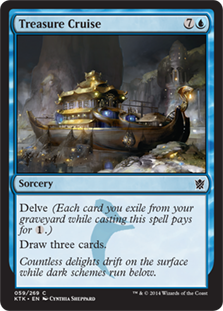 RUG Delver began its life in Modern as a tempo deck with a midrange plan B. It had significant success in 2012, its initial pro stint epitomized by Antonio De Rosa's 1st place finish at GP Turin. Some scattered finishes aside, the deck saw considerably less action after RTR, relegated to the format's fringes by BGx newcomers Abrupt Decay and Deathrite Shaman. Treasure Cruise heralded a promising return-to-form for the archetype, which finally forewent its midrange roots for a more singular tempo strategy. The infamous sorcery gave Delver a whopping 20% metagame share, and Immanuel Gerscenson took his own 1st place GP victory with RUG.
RUG Delver began its life in Modern as a tempo deck with a midrange plan B. It had significant success in 2012, its initial pro stint epitomized by Antonio De Rosa's 1st place finish at GP Turin. Some scattered finishes aside, the deck saw considerably less action after RTR, relegated to the format's fringes by BGx newcomers Abrupt Decay and Deathrite Shaman. Treasure Cruise heralded a promising return-to-form for the archetype, which finally forewent its midrange roots for a more singular tempo strategy. The infamous sorcery gave Delver a whopping 20% metagame share, and Immanuel Gerscenson took his own 1st place GP victory with RUG.
Wizards’s ensuing January bans put an end to the Cruising, spelling the end of Delver for many players. But the deck doesn’t need Treasure Cruise. Delver can pursue a tempo gameplan with another fantastic delve spell. To grasp the power of Hooting Mandrills, we must understand how Delver’s threats work together.
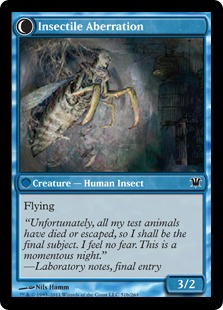 Few creatures promote a protect-the-queen strategy like Insectile Aberration. It steals games in a way Geist of Saint Traft or Goblin Rabblemaster, other classic tempo threats, can never hope to do. While these threats require you to spend cards clearing the ground, Delver simply flies over it, allowing you to eat damage while racing in the skies from the second turn onwards. Goyf also exemplifies the qualities of a blue-chip tempo threat, comfortably resolving before opponents represent their countermagic and ignoring most varieties of defense. While Delver’s evasion gets him through, Tarmogoyf leans on his massive bulk to deal damage; not many creatures can withstand a blow from the Lhurgoyf, allowing him to generate cards by eating defenders and to come in uninterrupted next turn.
Few creatures promote a protect-the-queen strategy like Insectile Aberration. It steals games in a way Geist of Saint Traft or Goblin Rabblemaster, other classic tempo threats, can never hope to do. While these threats require you to spend cards clearing the ground, Delver simply flies over it, allowing you to eat damage while racing in the skies from the second turn onwards. Goyf also exemplifies the qualities of a blue-chip tempo threat, comfortably resolving before opponents represent their countermagic and ignoring most varieties of defense. While Delver’s evasion gets him through, Tarmogoyf leans on his massive bulk to deal damage; not many creatures can withstand a blow from the Lhurgoyf, allowing him to generate cards by eating defenders and to come in uninterrupted next turn.
Hooting Mandrills boasts the best of both worlds, outclassing most blockers and pushing through damage even when confronted. Trample makes him a fair bit better than either Tasigur, the Golden Fang or Gurmag Angler in tempo, since the strategy counts on squeezing in small bits of damage wherever possible to run away with a win.
My starting list ran 2 Tarfire, 2 Vapor Snag, and a second Foothills in the flex slots, and was otherwise identical to the one I played at the IQ. The deck seemed extremely powerful in testing, but I couldn’t beat a Siege Rhino. Mana Leak was a start, and Simic Charm mitigated the problem.
Monkey Grow Core
This 55-card core only allots us 5 flex slots, but the high cantrip density ensures we’ll find our bullets when we need them. I ran 2 Snapcaster Mage, 2 Curiosity, and 1 Simic Charm in these slots for Worcester, anticipating a lot of Grixis Delver and some Abzan Midrange (our worst matchup). I wasn’t worried about anything else.
Card Choices
Creatures
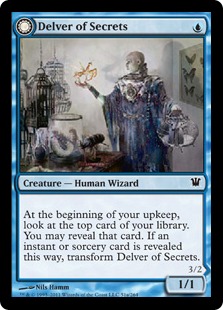 Delver of Secrets: RUG Delver’s namesake for a reason. To quote Jeff Hoogland: "The reason to play Delver is free wins. Sometimes you play this little guy on turn one, he flips on turn two, and you ride the Aberration to victory. I’ve won a number of games while stuck on exactly one land because my Delver flipped the turn after I played him."
Delver of Secrets: RUG Delver’s namesake for a reason. To quote Jeff Hoogland: "The reason to play Delver is free wins. Sometimes you play this little guy on turn one, he flips on turn two, and you ride the Aberration to victory. I’ve won a number of games while stuck on exactly one land because my Delver flipped the turn after I played him."
Tarmogoyf: Goyf was a mainstay in Delver decks before Delver even saw print. He’s the best stand-alone 2-drop in Modern and often demands multiple answers (i.e. two Bolts). In the words of mtgsalvation user Pizzap, "Strictly speaking Goyf dies to removal, but actually your removal is dying to Goyf."
Hooting Mandrills: One part Werebear, one part Nimble Mongoose. 4/4 isn't quite Shroud, but Mandrills dodges the ubiquitous Bolt and Decay. Tasigur and Angler outclass his stats, but trample brings him over the edge in tempo, and I can’t think of a fitter body for Curiosity.
Snapcaster Mage: Tiago’s infamous invitational card loves a shell like this one, recycling critical spells and providing an attacker. Thought Scour turns Snapcaster into an attacking Demonic Tutor, helping him cast the best Instant or Sorcery in the deck at a given time. I ran 1 for awhile and fit the second copy for an edge against Abzan.
Cantrips
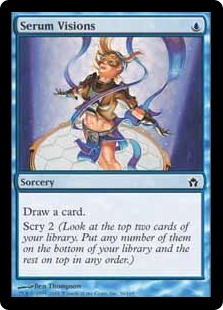 Serum Visions: The worst of the best but the best we've got. How about some perspective? Before Aerial Responder, Legacy Threshold lists complimented their Brainstorms with a set of these bad boys. Library manipulation is that powerful.
Serum Visions: The worst of the best but the best we've got. How about some perspective? Before Aerial Responder, Legacy Threshold lists complimented their Brainstorms with a set of these bad boys. Library manipulation is that powerful.
Gitaxian Probe: Flips Delver, fills the grave for Mandrills, squeezes value out of an early Snapcaster, clears the way for Curiosity, and Bolt-proofs Tarmogoyf. And all for a measly 2 life!
Thought Scour: Hyper-enables Mandrills and supports Goyf and Snapcaster.
Removal and permission
Lightning Bolt: Bolt is integral to Modern tempo decks since it’s more efficient and versatile than anything else in the format. Tempo always needs a specific tool to carry out its gameplan, explaining its reliance on cantrips. With its capability to either remove a creature or burn an opponent for one mana, Bolt embodies multiple tools in a single card at the lowest possible price. Early this season, the card wasn’t that good; January’s bans meant the rise of Abzan, and with it Tron on point duty. Now, Delver’s back, and with Collected Company picking up steam, Modern events are packed with juicy targets.
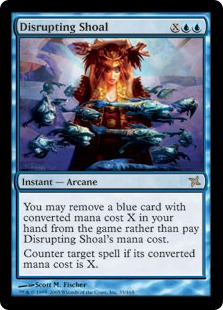 Disrupting Shoal: Shoal does two things here. It allows the deck to play very aggressive game 1s, and it hoses the linear archetypes that define Modern. Turn 1 Delver, turn 2 Goyf in a deck without Shoal might get there, but it might also lose to Lightning Bolt and Exterminate!. Conversely, leading with Delver and Shoaling an opposing Hierarch can devastate opponents. Mana Leak hits everything with CMC 3+, since by the time those spells see the stack we should have a threat and some mana. Shoal also gives us an edge against Infect, Bloom Titan, Burn, Living End, Bogles, and others. Modern’s lack of catch-all answers like Force of Will allows these decks to shape the format. But while the linear decks attack from different angles, and often demand very specific sideboard answers (Ancient Grudge, Feed the Clan, etc.), they all rely heavily on one- and two-drops. This deck is full of one- and two-mana blue cards. We have Force of Will.
Disrupting Shoal: Shoal does two things here. It allows the deck to play very aggressive game 1s, and it hoses the linear archetypes that define Modern. Turn 1 Delver, turn 2 Goyf in a deck without Shoal might get there, but it might also lose to Lightning Bolt and Exterminate!. Conversely, leading with Delver and Shoaling an opposing Hierarch can devastate opponents. Mana Leak hits everything with CMC 3+, since by the time those spells see the stack we should have a threat and some mana. Shoal also gives us an edge against Infect, Bloom Titan, Burn, Living End, Bogles, and others. Modern’s lack of catch-all answers like Force of Will allows these decks to shape the format. But while the linear decks attack from different angles, and often demand very specific sideboard answers (Ancient Grudge, Feed the Clan, etc.), they all rely heavily on one- and two-drops. This deck is full of one- and two-mana blue cards. We have Force of Will.
Mana Leak: Stronger than Goremand in this build, which absolutely needs hard answers to meaningful disruption. There are only so many cards in our opponent’s deck that can deal with a second-turn 4/4 6-drop, and if we stop the ones they happen to draw, we’ll win.
Stubborn Denial: Force Spike mode already isn’t bad against opponents aiming to slam Liliana of the Veil or Karn, Liberated on-curve. With a fatty out, the card turns into one-mana Negate. That 50% price reduction means a lot in a deck requiring such diligent budgeting – Denial only asks that we summon a green guy, which we want to do anyway.
Utility
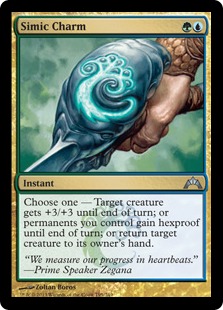 Simic Charm: The deck’s sleeper workhorse, Charm offers us three pertinent modes. Command of Unsummoning mode Time Walks opponents casting Wurmcoil Engine and Tasigur, removes tokens, and 2-for-1s Splinter Twin; Giant Growth wins ground wars and Lava Spikes opponents with an unblocked attacker; and Hexproof mode counters just about every removal spell, including Decay and even Molten Rain.
Simic Charm: The deck’s sleeper workhorse, Charm offers us three pertinent modes. Command of Unsummoning mode Time Walks opponents casting Wurmcoil Engine and Tasigur, removes tokens, and 2-for-1s Splinter Twin; Giant Growth wins ground wars and Lava Spikes opponents with an unblocked attacker; and Hexproof mode counters just about every removal spell, including Decay and even Molten Rain.
Curiosity: When I began testing for this summer’s Magic events, I wanted a fifth card type (artifact, enchantment, tribal, or planeswalker) to grow Goyf past Tasigurs, Anglers, and Rhinos. Thought Scour could generate extra value by “accidentally” milling these cards, but I still needed something appropriate for my low-curve, tempo-focused game plan. I started with Mishra's Bauble. It wasn’t bad in an opener and it didn’t make Delver much worse, adding variance to flips without compromising his flip percentage – we can sacrifice Bauble on our opponent’s turn and stack its “Draw a card” trigger before or after Delver checks the top card of our library to have two goes at flipping him. Still, I’d sometimes need an answer or a threat and draw a Bauble, forcing me to wait another turn. I wanted a card with mainboard applications in the Goyf mirror. Curiosity, a major player in Comer’s original Miracle Gro list, interested me since it can ruin Abzan’s primary plan of grinding out its opposition. It’s also decent elsewhere, as drawing an extra card each turn in a 17-land deck packed with counterspells and cantrips feels just as degenerate as it reads. The key to casting Curiosity is to wait for the perfect window. We don’t just slam it on our first threat and attack, because even if we draw a card before the threat dies – achieving card parity and Battlegrowthing the Goyfs of the future – we’ve lost an opportunity to Giant Opportunity for U. Just as I support Denial with 8 Ferocious enablers, Insectile Aberration and Mandrills make 8 evasive bodies for Curiosity. We can also pitch unused Curiosities to Shoal.
I’ve seen some pros suggest Ior Ruin Expedition for this slot. That card costs 2 (probably tapping us out on the turn we’d rather commit a threat or hold up permission), requires us to make 2-3 additional land drops (bringing us at least to 4 lands, an unlikely event in game 1) and provides a decidedly lackluster return. Curiosity can steal the game; Ior Ruin Expedition is only valuable in a few situations and, when it works, doesn’t do much anyway. Tarfire does well over Curiosity in a Jund/Collected Company-heavy meta.
Sideboarding
The Monkey Grow sideboard is as vital to the deck as the main 60, containing a few pivotal packages and some meta-specific flex slots. It’s almost transformational, offering anywhere from 8 to 12 cards in most matchups. I’ll go over the sideboard, then I’ll cover what to board out.
The sideboard
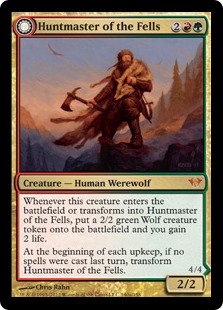 Huntmaster package: Huntmaster of the Fells // Ravager of the Fells gives us a lot of breathing room against Abzan, but it’s not Abzan-specific; Huntmaster comes in against every fair deck. The Human Werewolf excels in blue decks, since flipping him back and forth is effortless between Snapcaster and a cantrip suite. He provides an immediate burst of value and takes over a game if unanswered, like some fusion of Snapcaster and Dark Confidant. Casting him off 17 lands isn’t tough thanks to our cantrips and the inherent grindiness of games 2 and 3, and Path to Exile inadvertently ramps us into him. To play Huntmaster effectively, we hold him until we can ensure resolution, then pour energy into transforming him constantly. I can see cutting his numbers should Modern divert from midrange.
Huntmaster package: Huntmaster of the Fells // Ravager of the Fells gives us a lot of breathing room against Abzan, but it’s not Abzan-specific; Huntmaster comes in against every fair deck. The Human Werewolf excels in blue decks, since flipping him back and forth is effortless between Snapcaster and a cantrip suite. He provides an immediate burst of value and takes over a game if unanswered, like some fusion of Snapcaster and Dark Confidant. Casting him off 17 lands isn’t tough thanks to our cantrips and the inherent grindiness of games 2 and 3, and Path to Exile inadvertently ramps us into him. To play Huntmaster effectively, we hold him until we can ensure resolution, then pour energy into transforming him constantly. I can see cutting his numbers should Modern divert from midrange.
Blood Moon package: I started with 2 Blood Moons and moved to 3 for some added punch against Abzan. A control card, Moon shines in a tempo shell. It usually plays like two-four Time Walks, slowing down opponents enough for Delver to go the distance. It also destroys some decks on its own, among them Abzan Midrange, Bloom Titan, and Bogles.
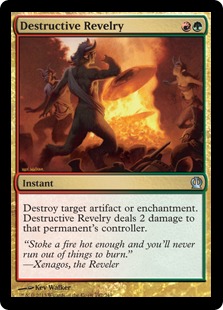 Revelry/Grudge package: Destructive Revelry efficiently answers problematic permanents while bringing opponents closer to 0 life. I wouldn’t want more than 2 in most matchups. Ancient Grudge needs less of an introduction, but it rarely comes in against non-Affinity decks. I’ve experimented with 1, 2, and 3 copies, and 2 seems like the sweet spot for this matchup.
Revelry/Grudge package: Destructive Revelry efficiently answers problematic permanents while bringing opponents closer to 0 life. I wouldn’t want more than 2 in most matchups. Ancient Grudge needs less of an introduction, but it rarely comes in against non-Affinity decks. I’ve experimented with 1, 2, and 3 copies, and 2 seems like the sweet spot for this matchup.
Flex slots: Just to be clear about my Worcester list, I never wanted Vapor Snag in the 75. I was counting on StarCityGames having the last copy of Simic Charm for me on site, and they didn’t. I ran Dismember to kill Rhino, Tasigur, Angler, and Tarmogoyf, and to help out against random creatures like Knight of the Reliquary and Archangel of Thune. Flashfreeze obviously counters Siege Rhino, but it also came in against Mono-Green Stompy, Zoo, and Jund. Some other cards to run in the flex slots include Rough // Tumble, Feed the Clan, Pillar of Flame, Engineered Explosives, Vendilion Clique, Spellskite, and the 4th Stubborn Denial.
What to cut
Disrupting Shoal: I’ve clarified Shoal’s game 1 strengths – without it, opponents have an easier time trading with us 1-for-1. Post-board, we actually benefit from 1-for-1s by getting ahead on cards with Curiosity and Huntmaster. It’s just icing that opponents fear the Arcane Instant the rest of the match. At Worcester, I kept the Shoals against Affinity and Bloom Titan, and cut them in my other 10 rounds.
Thought Scour: When we’re trading cards with opponents, the graveyard fills up by itself. We also don’t need to cantrip as much since the interactive nature of post-board games gives us time to draw lands for Huntmaster. Scour stays in against decks that don’t give us a way to interact early on (i.e. Amulet Bloom, Tron).
Lightning Bolt: Close to useless against any deck without on-board targets. We want counterspells and threats for these matchups, not Lava Spike.
Gitaxian Probe: Perfect information is incredibly valuable. I only cut Probe against Burn.
Why Not Grixis?
The only Modern Delver lists putting up results lately splashes black for Tasigur and Angler. I currently don’t think the Grixis decks are as good as mine. A few reasons to play RUG instead:
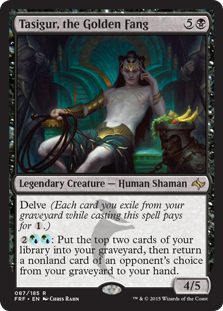 Mandrills and Goyf over Tasigur and Angler: I’ve already discussed trample in Delver decks; the keyword beats an extra point of toughness, particularly assuming Simic Charm backup and the fact that Flame Slash has largely fallen off in favor of Dismember and Roast (thanks, Siege Rhino!). Black fatties aside, 4/4 still trumps most bodies in Modern. x/5 stats are mostly relevant against Siege Rhino decks, which stomp Grixis Delver anyway. Gaining a slight edge in a practically unwinnable matchup is not a valid reason to favor Tasigur over Mandrills, as RUG offers more in this department regardless with Huntmaster and Blood Moon to trump Abzan. Mandrills is also the color of money – Gurmag Angler is big, but it’s smaller than a 5/6 Tarmogoyf, which RUG Delver can be tuned to enable (as it was for Worcester).
Mandrills and Goyf over Tasigur and Angler: I’ve already discussed trample in Delver decks; the keyword beats an extra point of toughness, particularly assuming Simic Charm backup and the fact that Flame Slash has largely fallen off in favor of Dismember and Roast (thanks, Siege Rhino!). Black fatties aside, 4/4 still trumps most bodies in Modern. x/5 stats are mostly relevant against Siege Rhino decks, which stomp Grixis Delver anyway. Gaining a slight edge in a practically unwinnable matchup is not a valid reason to favor Tasigur over Mandrills, as RUG offers more in this department regardless with Huntmaster and Blood Moon to trump Abzan. Mandrills is also the color of money – Gurmag Angler is big, but it’s smaller than a 5/6 Tarmogoyf, which RUG Delver can be tuned to enable (as it was for Worcester).
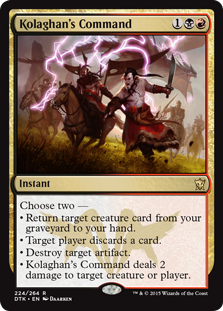 Huntmaster of the Fells over Kolaghan’s Command: Both of these value spells give casters a boost in resource wars. Kolaghan's Command is cheaper, but in a grind, one extra mana doesn’t matter much. Command Aether Shockwaves a troublesome creature, but an untouched Huntmaster machine-guns defending lines turn after turn while breeding an army of Wolves. Drawing Command gives Grixis players back their best creature that’s died this game, whereas drawing Huntmaster gives RUG players the best creature in their decks. He's already a two-for-one, at worst eating valuable removal and at best eating the whole game. It’s true that Huntmaster won’t kill artifacts, but RUG already alotts us the best artifact hate in the format (Ancient Grudge) as well as the most flexible and tempo-positive (Destructive Revelry).
Huntmaster of the Fells over Kolaghan’s Command: Both of these value spells give casters a boost in resource wars. Kolaghan's Command is cheaper, but in a grind, one extra mana doesn’t matter much. Command Aether Shockwaves a troublesome creature, but an untouched Huntmaster machine-guns defending lines turn after turn while breeding an army of Wolves. Drawing Command gives Grixis players back their best creature that’s died this game, whereas drawing Huntmaster gives RUG players the best creature in their decks. He's already a two-for-one, at worst eating valuable removal and at best eating the whole game. It’s true that Huntmaster won’t kill artifacts, but RUG already alotts us the best artifact hate in the format (Ancient Grudge) as well as the most flexible and tempo-positive (Destructive Revelry).
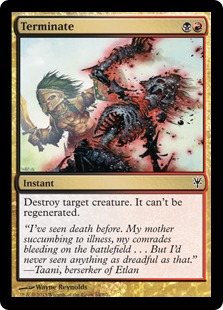 Simic Charm over Terminate: RUG will never get a card that kills as dispassionately as Exterminate!, but Grixis can only dream of a two-drop as dynamic as Simic Charm, which I posit provides a better effect in the Delver deck than even the pricier Kolaghan's Command. Charm may only remove creatures temporarily, but it also helps Mandrills trample over challengers, provides reach with an unblocked threat, and counters removal spells. Tempo decks need their cards to do many things at once. That's why we can't have Delver in non-red colors; Bolt is way too versatile and powerful to give up in this format. (Legacy has BUG Delver precisely because there are cards in that format that match Bolt's level of versatility and power in BUG colors, such as Deathrite, Daze, and Aerial Responder). Terminate is very good at doing one thing, but it can't do anything else. We win the game on small margins. Killing the hell out of a creature is worse than delaying it a turn if it means giving up the plasticity of Simic Charm, especially when bouncing it for a turn often gets the job done.
Simic Charm over Terminate: RUG will never get a card that kills as dispassionately as Exterminate!, but Grixis can only dream of a two-drop as dynamic as Simic Charm, which I posit provides a better effect in the Delver deck than even the pricier Kolaghan's Command. Charm may only remove creatures temporarily, but it also helps Mandrills trample over challengers, provides reach with an unblocked threat, and counters removal spells. Tempo decks need their cards to do many things at once. That's why we can't have Delver in non-red colors; Bolt is way too versatile and powerful to give up in this format. (Legacy has BUG Delver precisely because there are cards in that format that match Bolt's level of versatility and power in BUG colors, such as Deathrite, Daze, and Aerial Responder). Terminate is very good at doing one thing, but it can't do anything else. We win the game on small margins. Killing the hell out of a creature is worse than delaying it a turn if it means giving up the plasticity of Simic Charm, especially when bouncing it for a turn often gets the job done.
Disrupting Shoal: Another thing Charm does is pitch to Disrupting Shoal. Grixis Delver can’t support the card, as it runs a good deal more nonblue cards than RUG, among them Young Pyromancer, Exterminate!, Kolaghan's Command, and Murderous Cut. Shoal helps us play an all-out tempo game, tapping out for threats on turns 1 and 2 without fearing opposing resistance.
Improved linear matchups: Shoal “fixes” all our linear matchups. Revelry trounces Bogles. Storm can’t beat Stubborn Denial. Grixis has Kolaghan's Command for Affinity, but RUG gets Grudge. The biggest upgrade comes with Burn. Grixis Delver lists have moved to Death's Shadow in the board to help out here, but we have a “mainboard” Shadow in Lhurgoyf form. Even Mandrills can force through some damage against Burn pilots aiming to chump lethal attacks and topdeck Boros Charm for your head. Huntmaster also plows Burn decks by clogging the board, removing creatures, gaining life, and trampling for lethal.
Grixis Delver’s primary upside is its ability to transition seamlessly into a midrange role. Electrolyze, Command, and Exterminate! all slot happily into this plan. On the other hand, this benefit weakens the deck’s tempo game. Grixis can also “go wide" with Young Pyromancer, something the Mandrill deck, in its current incarnation, cannot do. Monkey Grow could accommodate Pyromancer itself, but I prefer the creature suite of Delver/Goyf/Mandrills right now.
Matchups
To determine the deck’s matchups, I jammed dozens of hours weekly with the deck against skilled Modern players, constantly tweaking the 75 as I went. The results are by no means conclusive, but they’ve served me well during event preparation.
Favorable MUs
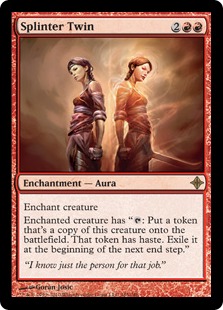 Splinter Twin: Twin hates facing big green creatures. It’s trivial to slide a threat under Goremand and Mana Leak, and our own Leaks love those three-mana Exarchs. Stubborn Denial nabs Cryptic Command or the second Bolt for our fatties. Simic Charm blows out the combo. Huntmasters from the board dominate the midrange mirror in game 2.
Splinter Twin: Twin hates facing big green creatures. It’s trivial to slide a threat under Goremand and Mana Leak, and our own Leaks love those three-mana Exarchs. Stubborn Denial nabs Cryptic Command or the second Bolt for our fatties. Simic Charm blows out the combo. Huntmasters from the board dominate the midrange mirror in game 2.
Infect: Good Infect pilots will recognize the times they need to pump their creatures, and we remove their threats either in response to these moves or when we’re sure they won’t have an answer (i.e. vs. a tapped out opponent during our Main Phase). Revelry/Grudge hits Wild Defiance and Blinkmoth Nexus. Shoal counters every threat, and Moon keeps more from resolving.
Bloom Titan: Fast pressure and efficient disruption make a nightmarish combination for all combination decks. Curiosity keeps the counterspells flowing, and Blood Moon from the side entirely shuts Bloom Titan down.
GR Tron: Tron is built to crush midrange, so Delvers and Leaks naturally predate it. Goyf and Mandrills blank Pyroclasm. Our countermagic stops real cards like Karn and Oblivion Stone. Simic Charm keeps Tron off its Wurmcoils, and Moon from the sideboard slows it to a crawl.
Reasonable MUs
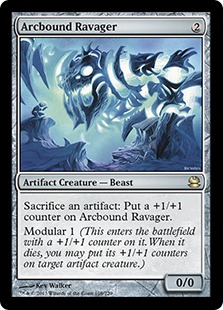 Affinity: Game 1 asks us to race Affinity, which seldom works. Post-board we’re firmly midrange, cutting threats for disruption and keeping Affinity off its “money cards” (Arcbound Ravager, Steel Overseer, Master of Etherium, Cranial Plating). Insectile Aberration can play defense while we wait for Huntmaster.
Affinity: Game 1 asks us to race Affinity, which seldom works. Post-board we’re firmly midrange, cutting threats for disruption and keeping Affinity off its “money cards” (Arcbound Ravager, Steel Overseer, Master of Etherium, Cranial Plating). Insectile Aberration can play defense while we wait for Huntmaster.
Burn: Tarmogoyf and Hooting Mandrills wall Burn early on and become huge clocks when we draw a second creature. Post-board, they stabilize until Huntmaster takes over.
Jund: Much easier to defeat than its greedy cousin. Our Bolts actually do something in this matchup, and Confidant helps us in the damage race. Moon turns off manlands and complicates casting Liliana. Jund’s lack of beefy blockers like Siege Rhino lets Hooting Mandrills tear up the ground.
Grixis Delver: This matchup often devolves into a midrange grindfest, so Huntmaster pulls a lot of weight. Tasigur and Angler wall Mandrills, making Simic Charm very important.
Merfolk: Like all Aether Vial decks, Merfolk is great when it opens with one. Disrupting Shoal does a Mental Misstep impression in those situations, and the Revelry package post-board keeps the deck slow enough for Huntmaster to run it over.
Collected Melira: Without Collected Company or Chord of Calling, this deck is a bad aggro deck. Denial keeps these Instants from resolving, and Bolting mana dorks gives us time to find it. Our bodies outclass theirs, but CoCo can run us over if it gets going, so we mainly want threats and counterspells in this matchup.
Bad MUs
 Abzan Midrange: A nightmare. Every card in the deck stomps us. Huntmaster’s a hard-to-remove body that generates card advantage, but if Abzan players find their removal spell, we’re back on defense. Getting lucky with Blood Moon is our best shot.
Abzan Midrange: A nightmare. Every card in the deck stomps us. Huntmaster’s a hard-to-remove body that generates card advantage, but if Abzan players find their removal spell, we’re back on defense. Getting lucky with Blood Moon is our best shot.
Naya Zoo: Zoo out-aggresses the Delver deck while pointing its ample removal at our outnumbered threats. Huntmaster and Tarmogoyf are paramount to survival, and Revelries come in to answer Choke. Naya Zoo is the only deck I lost to at the Modern IQ.
How to Play
Despite the deck’s obvious gameplan, playing Monkey Grow is extremely challenging. Its wealth of one-mana spells gives pilots a huge amount of potential plays each turn and greatly rewards those who dedicate energy to learning the lines. There are far too many playlines to explain in one article, but I’ll list a few to get prospective Monkey Grow players started.
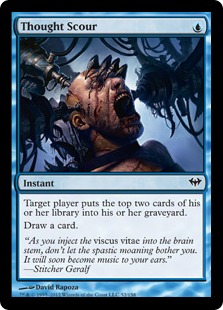 Don’t always cantrip. A few reasons to hold them in your hand include transforming Ravager of the Fells back into Huntmaster, having a card to exile to Disrupting Shoal, gaining additional info from Gitaxian Probe, digging for a specific answer with scry after your opponent presents a certain threat, and waiting to mess up up your opponent’s scry with Thought Scour. As a rule, if you have other things to do with your mana and like your hand and board positioning, don’t cantrip.
Don’t always cantrip. A few reasons to hold them in your hand include transforming Ravager of the Fells back into Huntmaster, having a card to exile to Disrupting Shoal, gaining additional info from Gitaxian Probe, digging for a specific answer with scry after your opponent presents a certain threat, and waiting to mess up up your opponent’s scry with Thought Scour. As a rule, if you have other things to do with your mana and like your hand and board positioning, don’t cantrip.
If you’re going to cantrip this turn, do so pre-combat. You may draw Curiosity. This strategy also protects your threats; if you smell a Exterminate! and have a Shoal in hand, you can cantrip before attacking to dig for a two-drop. If you won’t have mana for Curiosity, wait until the latest possible time to cantrip – after combat, or on your opponent’s end step in Scour’s case. Waiting gives away less information about your lines and represents tricks like Denial.
Effectively sequence your threats. You generally lead with Tarmo, since Mandrills is best when he costs only G and doesn’t cannibalize the Lhurgoyf. Still, if Goyf won’t top 2/3 or even 3/4 until turn 4, maybe you lead with Mandrills to turn on Denial. Ask yourself how the next few turns will play out and decide which creature you’d rather have in play each turn. Plan your mana spending accordingly, and turns in advance.
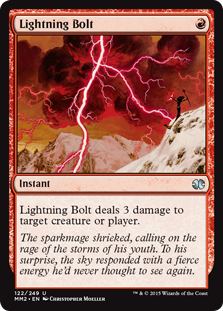 Count your on-board damage and pay attention to your opponent’s. Consider your options, and his, for getting in extra points with reach. Learn when to start pointing those Lightning Bolts at your opponent’s head – Mike Flores’s stellar article “The Philosophy of Fire” might help.
Count your on-board damage and pay attention to your opponent’s. Consider your options, and his, for getting in extra points with reach. Learn when to start pointing those Lightning Bolts at your opponent’s head – Mike Flores’s stellar article “The Philosophy of Fire” might help.
Pace your most versatile cards. With a Delver on the table, do you cast Simic Charm, Mana Leak, or Snap-Stubborn to counter your tapped out opponent’s Forked Bolt? If you expect Abrupt Decay, you might want to save Charm. If Probe showed you Keranos, you may keep the Mana Leak. If your opponent has an empty board, cementing your advantage with Snapcaster Mage might justify losing an answer to Dismember. Keep in mind the most important cards in a given matchup and sequence your permission and utility to give yourself the most options down the road.
Going Forward with Hooting Mandrills
With Abzan Midrange on the decline and Jund picking up steam, Monkey Grow is even better positioned than it was at the IQ. I’d definitely run a third Simic Charm in the sideboard and would like the full set in exchange for Dismember or Flashfreeze. As long as Modern teems with linear aggro and combo strategies, the build will remain a dangerous competitor.
Miracle Grow reinvented resource management. Deckbuilders applied its groundbreaking principles across formats, culminating in decks as potent as Gro-A-Tog and Canadian Threshold. Card velocity machines designed to extract maximal value from limited resources, the decks all share a steep learning curve and promise success to their best pilots. Those who give Monkey Grow the hours it deserves, committing time and patience to discovering its many intricacies, will find themselves among the first to experience the timeless strategy’s explosive power in Modern.


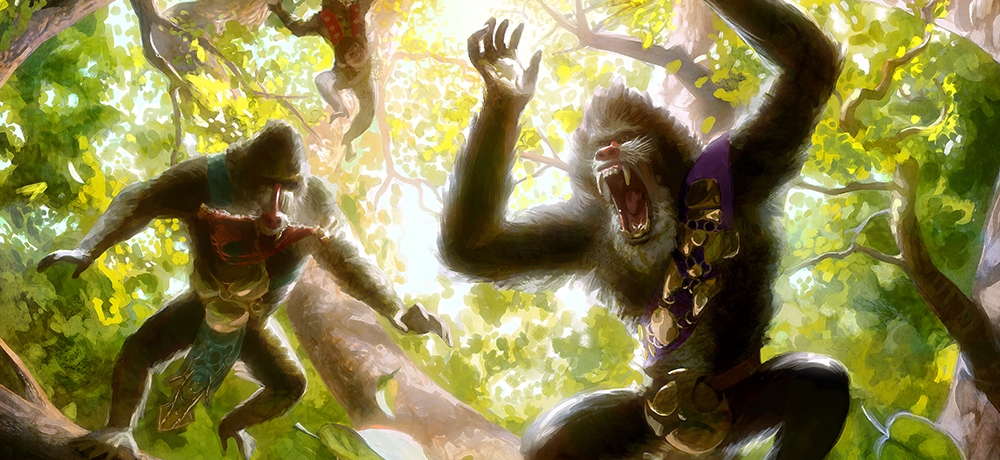


I did have the pleasure to enjoy the creation process of this and other delver decks with Jordan (mainly countercat variations) and deeply value his insight regarding tempo decks in modern. His understanding, as is underlined by this article, surpasses even that of dedicated modern specialists in this area and highlights the unused deck design space in modern.
Regarding card choices I do know that your testing process was very intense and every card has shown over and over again why it should be included over other choices (even curious ones 😉 – therefore I advice people to play the deck as it is for at least a couple of tournaments (besides the SB) before making any changes.
I hope to see more modern content from you in the near future – there will be always room to brew competitively. You are a brilliant and innovative mind, a deep intellectual understanding of the game and hard work are the road you are currently on that will keep you above the curve 🙂
Regards,
Philip
Amazing article. I greatly enjoyed the concept of this deck, and getting an in-depth breakdown like this is awesome. I was wondering, however, if you would consider a card like Savage Knuckleblade to be useful in your shell? I know the CMC3 thing is a bit of a problem for a deck as low on lands as yours, but I think it may be worth it thanks to its sheer size and flexibility (also gives you the ability to Shoal anything CMC3 and thus be even more aggressive early game).
Apart from that, this was awesome. I look forward to seeing more results with it!
Right… so you just replaced one brewer with another, except this one is a way better Magic player who actually goes to events? I mean, come on, it’s a homebrew, really. The archetype has never seen any significant success and there are plenty of reasons for it.
I mean, the dude is obviously very good at Magic and deckbuilding and has the guts and skill to bring a brew like this to an event and win against very competitive players but that doesn’t change the fact that it’s a tier 2.5/3 deck that happened to be played by the right person in the right meta with the right randomly decided matchups. Props and best of luck to Mr. Boisvert, but I’m still waiting to see some competitively-oriented content.
Thanks for voicing these concerns. First, we haven’t replaced Sean with anyone. Jordan has not yet been added to the staff, although you will see some more of his pieces in the coming Fridays.
Second, with respect to “brews”, there’s a difference between Vampires lists without tournament results, and taking down a large 8 round event with a new version of a once-established deck. Temur Delver was a powerhouse back in November and December, and an easy tier 2 contender. This just represented one way of remaking it in the current metagame. In fact, it is the most successful Temur Delver list in the current metagame: think of it as a checkin on a previously competitive deck that still shows promise. We aren’t just interested in reporting on the tier 1 and tier 2 decks. We also want to identify up-and-coming decks in the format and how those decks can work for our readers.
You can expect to see at least 4 days of straight competitive (tier 1 and tier 2 content, along with theory and discussion related to tournament-level Modern) on any given week. Friday will be the only day this might shift to decks like Jordan’s, but even then it won’t be an every-Friday sort of thing. That means out of 20-some articles in a given month, you will only see 3-4 on “brew” or “grassroots” style decks. But definitely keep letting us know how the content is. If it’s not working for you, chances are it’s not working for others and that’s something I want to know.
One thing that comes up to mind is having more transparency on the… “content schedule”? Whatever you call it, whenever you want to be consistent in what type of content comes out on what day (which looks like you’ve been doing since the inception of this place and is definitely the right approach), it should probably be mentioned somewhere and pinned to the front page.
Also, while sticking to only one article a day is fine, more would be what we Magic players like to call “strictly better”. You are trying to gain ground in a medium with no shortage on content and creators and the only thing that will set you apart is how much work you are willing to put in. To that point, you have to consider you are, more or less, in the gaming industry. The weekend is the most active part of the week (this is especially true for Magic players) and having no content then is baffling at best. That’s like a game store not working on weekends. They would go bankrupt. Usually in this business Monday is the day-off.
Just some feedback from a customer. Because let’s be real, this *is* a business (even though I doubt that’s why you are doing it) and since I’ve turned adblock off for you, I’m practically giving you money. I know most people aren’t as picky as me, but I don’t have all day to browse through content and when I do I expect certain quality. This article for instance, even though it’s very good indeed, is not exactly what I was expecting when more “spike” content was announced, despite technically being exactly that.
1) We are working towards some kind of content schedule, but it probably won’t be as defined as you are discussing here. Wednesdays are going to be a stats day and Tuesdays are going to be a weekend-in-review sort of day, where we pick some aspect of the weekend’s results/lists and discuss it in detail. But otherwise, Monday and Thursday will be more open. This gives us more flexibility as we add writers. Once we get up to two articles per day, there will probably be a guaranteed article on any given day and then one “flex” article.
2) Weekend content is a work in progress. Not all MTG sites do it and it’s unclear what the best kind of weekend content will be. This could be dynamic coverage of an event, it could be week-in-reviews, or it could just be more articles. The bottleneck there is obviously writers, which is something we are working to fix.
3) We definitely understand the business aspects of this and are thinking of it that way. But I also come from a data background and don’t want to make hasty decisions without both a plan and some underlying metrics, so that’s why some changes are going to be gradual and others will be quicker. I’m sorry to hear you weren’t a fan of this article, and keep letting us know how the others are doing.
Oh, no, I am a fan of the article itself, it’s very well put together, the guy knows how to write and it was most certainly interesting. But the topic itself wasn’t what I was personally expecting to find.
As one of the people who complained about the less than spikey content on here, I completely disagree with your assessment.
This article is a perfect example of what we should be seeing on the brew side. Something that has done well, is slightly off radar and the article was written very well.
RUG Delver just took down a major event, and Modern Nexus was the first site to get an indepth analysis of the deck (if you exclude the MTGS forums). This puts the site ahead of the curve. Now the deck may be a flash in the pan never to be repeated, or it might be the next big thing. At least we have some insight into the deck and the decisions that went into it and can make our own decisions.
Agreed. This type of article is what the modern cummunity needs… Not another vampire tribal article, and certainly not another burn primer.
Nicely done.
To Jordan –
Great deck and well done on first place. I loved Mandrills when I first saw them and will be giving this deck a try out. Did you see Adam Fronsee’s 12th Place BUG list which is based off yours?
http://sales.starcitygames.com//deckdatabase/displaydeck.php?DeckID=85621
To Nickolay and Sheridan –
While I like the data analysis side of the site it is articles like this and the other brews that I enjoy most. Now I know you have said you are moving away from that but I thought I would give you another ‘customers’ perspective. As for weekends I am usually busy with either family or actually playing the game so any content published then would not be looked at until Monday. Which means I am quite happy with a five day article week.
I’m glad to hear these kinds of “brews” are more the style people are looking for. There is definitely a place for these decks in Modern and it’s important that we cover them when we see signs of success. It’s one thing to cover tribal Vampires or other decks without a lot of competitive success. Those decks are still interesting exercises and might have potential, but they also just aren’t the spike-oriented content people expect. A Temur Delver build, however, is exactly where we want to see the “brews” going. My guess is that other readers feel the same way, although only time and more data will tell for sure.
I have to admit that while they were interesting, the vampire brews weren’t what drew me to this site. Originally it was the data analysis (following from the meta threads on MTGS) but since there’s been a lot of great artcles on much more than that.
This type of article is very much appreciated. I agree with the above poster that it puts you ahead of the curve and I think it’s great to get the rationale behind deck/colors/card choice for a somewhat unusual deck that has been so well tuned. Especially one that has had recent tournament results. There’s a lot of valuable info here even if RUG delver ends up only experiencing a flash in the pan success.
Since Burn has been splashing green for Revelry/Command, I’ve thought about Mandrills as another option.
Loved the article, just a quick nitpick, when describing Disrupting Shoal you mention LIving End as a linear deck that it shuts down, when in fact is as one hundred percent dead in that matchup as there are no blue spells with CMC 1 to counter living end, unless i’m missing something.
nevermind im dumb ^^^^^
just pay zero for disrupting shoal, got it 🙂
another top 8 in Europe for this kind of brew :
https://fr.magiccardmarket.eu/MKMSeries/main.php?tag=20&idt=2&idev=16